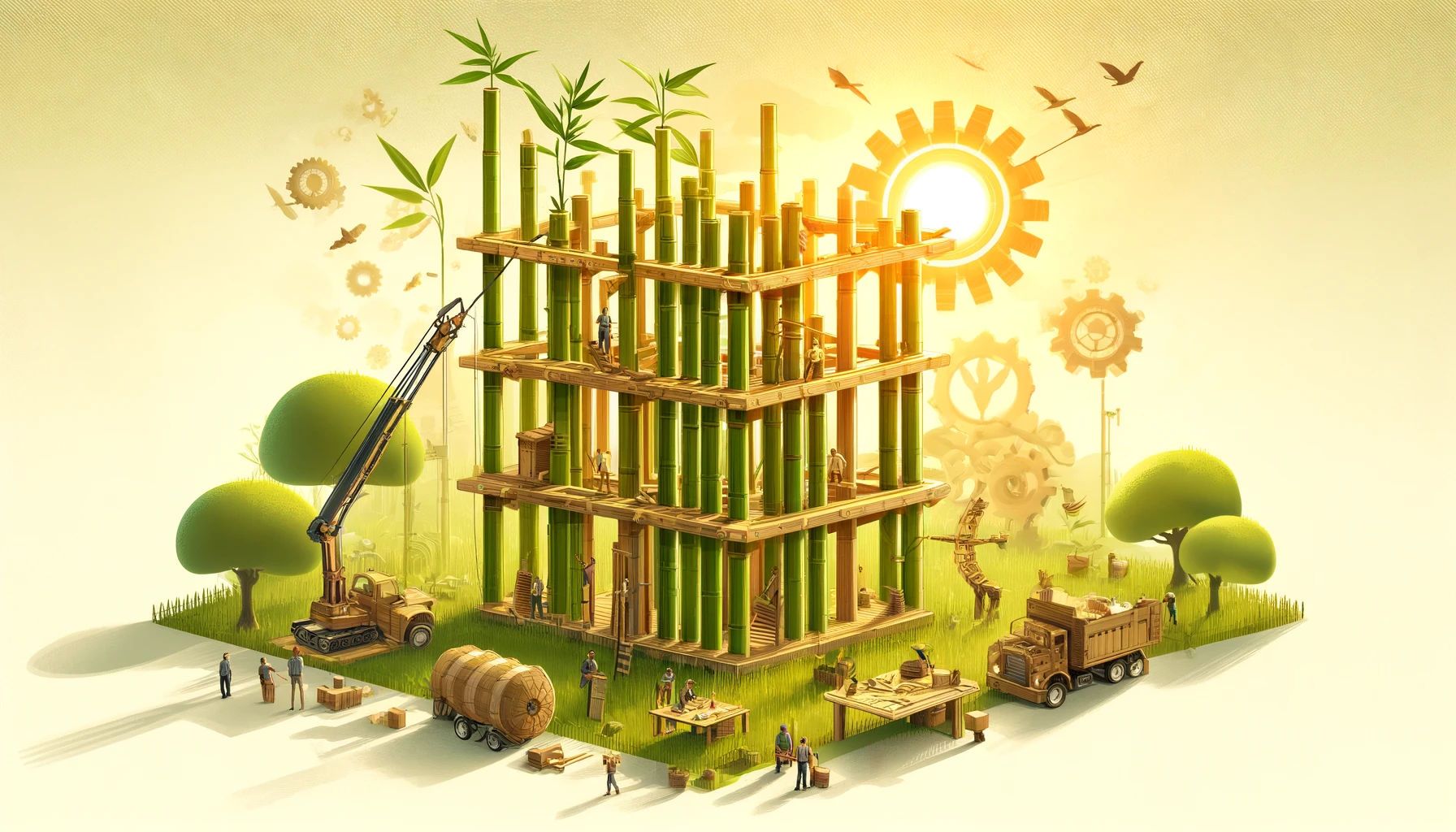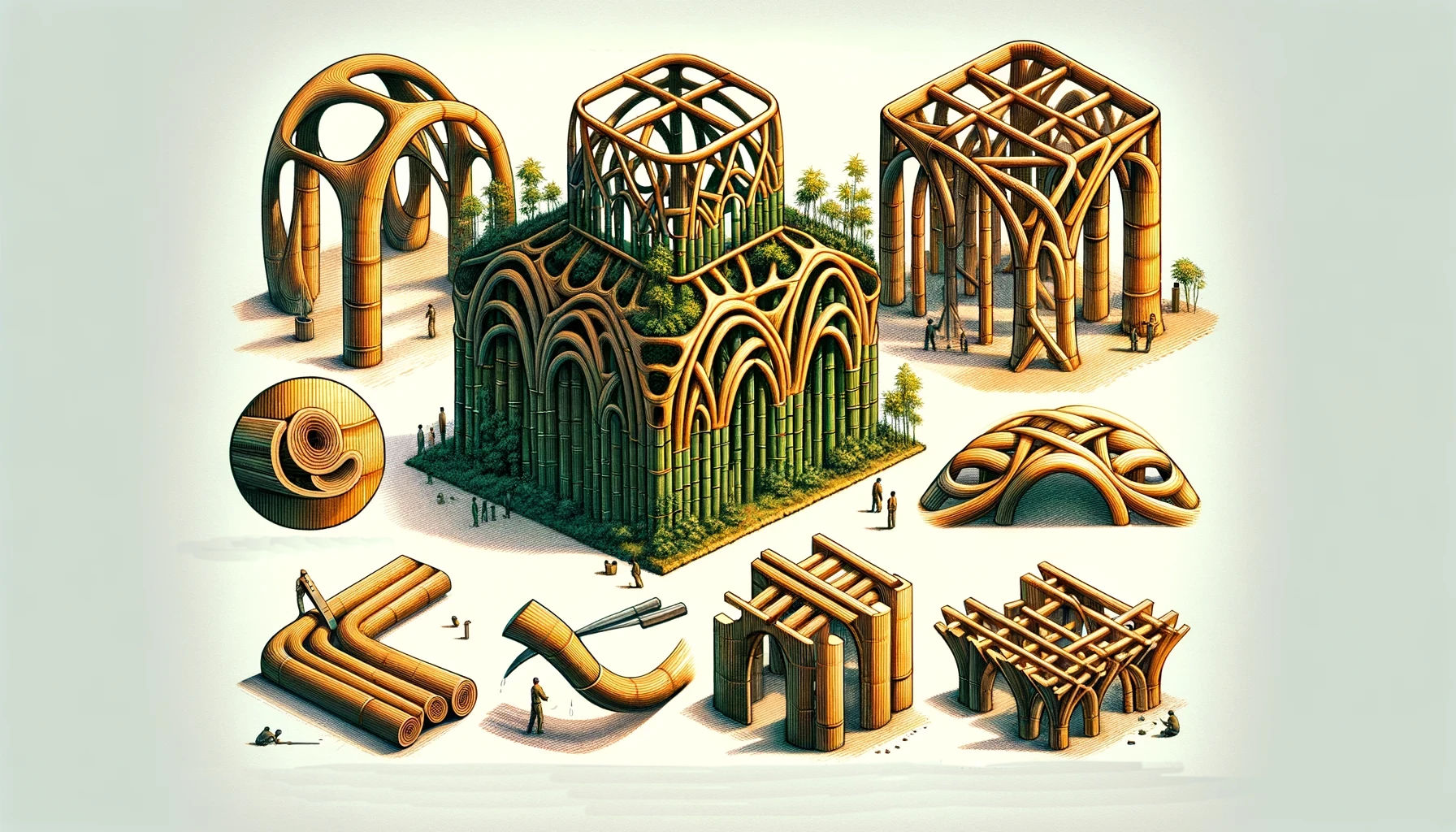Innovative Bamboo Engineering

Revolutionizing Construction: The Bamboo Engineering Renaissance
In the realm of construction and engineering, the quest for sustainable materials that don't compromise on strength or versatility has led to a resurgence of interest in one of the oldest materials known to humanity: bamboo. This remarkable plant, often underestimated, is making a powerful comeback, proving to be much more than just a symbol of the exotic or the material of choice for quaint garden furniture. Today, bamboo stands at the forefront of modern engineering applications, heralded for its exceptional qualities and its potential to redefine our approach to building and design in the 21st century.
Bamboo's journey from traditional use in small-scale construction to its current status as a highly sought-after material for innovative engineering solutions is a testament to its unique blend of attributes. It is not only sustainable, renewing itself rapidly compared to traditional timber, but also boasts a tensile strength that rivals steel. These characteristics, coupled with a growing global emphasis on eco-friendly and sustainable construction practices, have catapulted bamboo into the spotlight of modern engineering projects.
As the world grapples with the challenges of climate change and the environmental impacts of conventional construction materials, bamboo offers a glimmer of hope. Its application in modern engineering not only aligns with the goals of sustainable development but also opens up new avenues for architectural creativity and structural innovation. This article aims to delve into the world of innovative bamboo engineering, exploring its unique properties, the cutting-edge techniques employed in its treatment and shaping, and the remarkable structures it helps create. From traditional wisdom to modern innovation, bamboo engineering is poised to be a pivotal element in shaping a sustainable future for the construction industry.

Unique Properties of Bamboo: Unveiling Its Strength and Sustainability
Bamboo's exceptional qualities are reshaping the way we think about building materials in the 21st century. Among its most remarkable features are its tensile strength, sometimes comparable to steel, and its astonishing growth rate. These attributes, combined with its sustainability factors such as carbon sequestration and rapid renewability, position bamboo as a viable and eco-friendly alternative to traditional materials.
The Remarkable Strength of Bamboo
Bamboo's tensile strength is a standout property, drawing comparisons to steel, one of the most durable and widely used construction materials. This grass, often mistaken for a tree, has a fibrous structure that provides incredible resilience and flexibility. Processed bamboo, particularly in forms such as laminated or engineered bamboo, showcases this strength most prominently, making it an ideal candidate for construction and furniture design. Its ability to withstand considerable stress without breaking is a testament to its potential as a sustainable building resource.
Bamboo's Astonishing Growth Rate
One of the most compelling advantages of bamboo is its growth rate, which is unmatched by any other plant suitable for construction. Bamboo can grow up to several feet in a single day, with maturity reached in just 3 to 5 years. This rapid growth cycle ensures a sustainable supply of the material, unlike hardwood trees that can take decades to reach maturity. This factor alone significantly enhances bamboo's viability as a renewable resource, ensuring that its use does not deplete forests or harm ecosystems.
Sustainability and Environmental Benefits
When it comes to sustainability, bamboo is in a league of its own. Its rapid growth and renewability are just the beginning. Bamboo plays a crucial role in carbon sequestration, absorbing carbon dioxide from the atmosphere at a rate higher than many other plants. This makes it a valuable asset in the fight against climate change. Additionally, bamboo's ability to regenerate from its root system without the need for replanting minimizes disruption to the soil and surrounding environment, preserving biodiversity and preventing erosion.
Moreover, sustainable harvesting practices further enhance bamboo's environmental benefits. By selectively cutting mature stalks, the plant continues to grow and absorb CO2, ensuring that bamboo plantations can function as effective carbon sinks for years. This aspect of bamboo's lifecycle underscores its role in creating a more sustainable and environmentally friendly construction industry.
In summary, bamboo's unique properties, including its tensile strength comparable to steel, rapid growth rate, and exceptional sustainability aspects, make it an extraordinary material. Its ability to sequester carbon and regenerate quickly without the need for replanting positions bamboo as a frontrunner in the quest for green building materials. As we continue to explore and innovate within the realm of sustainable construction, bamboo stands out as a beacon of potential, promising a future where buildings are not just structures, but active participants in the health of our planet.

Zev Bianchi
As an enthusiastic champion of sustainability, I am committed to protecting our environment and fostering awareness about sustainable solutions. My blog serves as a platform where I, with the support of advanced AI, delve into the fascinating world of bamboo. This collaboration enables me to offer a unique perspective, combining human insight with AI's analytical prowess to present thorough and engaging content. Together, we explore bamboo's versatility, environmental advantages, and its pivotal role in eco-friendly practices. Join our journey to uncover the innovative and sustainable potential of bamboo, as we strive to make a meaningful impact on our planet's future.
Related Articles
THE BCOMPACT ORIGINAL
Folding Staircase
A beautiful, solid, space creating piece of furniture that's a staircase when you need it, and art when you don't.
The one true original foldable staircase.
Innovative Shaping and Treatment
Shaping Bamboo into Desired Structures
One of the most fascinating aspects of bamboo is its versatility, which is significantly enhanced through innovative shaping techniques. Traditionally, bamboo's natural form was a limiting factor, but modern methods have expanded its application, allowing for the creation of intricate and customized shapes such as arches and squared cross-sections. Two primary methods stand out in the shaping of bamboo: compression during growth and the application of heat and pressure post-harvest.
- Compression During Growth: This technique involves manipulating bamboo while it's still growing. By applying controlled pressure or guiding the bamboo's growth path with physical constraints, it's possible to influence its natural shape. This method requires a deep understanding of bamboo's growth patterns and a strategic approach to applying tension or compression forces at various stages of development. The result is bamboo that grows into predetermined shapes, reducing the need for mechanical alterations post-harvest and preserving the integrity of the bamboo's natural structure.
- Applying Heat and Pressure: Post-harvest, bamboo can be shaped into almost any desired form through the application of heat and pressure. This process, often referred to as bamboo bending, involves softening the bamboo by steaming or boiling it, which makes it pliable. Once pliable, the bamboo is bent into the desired shape and held in place until it cools and dries, retaining the new form. This method is particularly effective for creating curved or angular structures and is widely used in furniture making and architectural applications.

Bamboo Preservation Techniques
Preserving bamboo is crucial to enhance its durability and resistance against insects, fungi, and decay. Several techniques have been developed to protect bamboo, ensuring it remains a viable material for construction and manufacturing.
- Chemical Treatments with Borax and Boric Acid: One of the most effective methods for preserving bamboo involves using chemical agents like borax (sodium borate) and boric acid. These substances are known for their insecticidal and fungicidal properties. By soaking bamboo in a solution of borax and boric acid, the fibers are imbued with protective properties that deter pests and prevent fungal growth. This treatment penetrates deep into the bamboo, offering long-lasting protection without significantly affecting the bamboo's natural properties.
- Boiling to Remove Starches: Bamboo's natural starch content attracts insects and pests, which can lead to decay. Boiling bamboo is a traditional method used to remove these starches, effectively reducing its vulnerability to infestation. The process involves submerging bamboo in water at a rolling boil for a certain period, which leaches out the sugars and starches. After boiling, the bamboo is dried, which further hardens and preserves the material. This method not only protects the bamboo but also enhances its durability by reducing the likelihood of cracking and splitting.
These innovative shaping and treatment techniques have revolutionized how bamboo is used, transforming it from a traditional material with limited applications to a modern, versatile option for construction, furniture, and beyond.
The exploration of bamboo's role in modern structural applications reveals a fascinating intersection of traditional methods and cutting-edge technology. This section delves into how bamboo's inherent properties - notably its flexibility and strength - are harnessed through various structural systems and enhanced by modern advancements.
Post and Beam Structures
Bamboo's application in post and beam structures showcases its remarkable load-bearing capacity. This system, a staple in construction for millennia, benefits significantly from bamboo's tensile strength. Bamboo poles are used as vertical posts and horizontal beams, creating a framework that supports the structure's weight. The lightweight nature of bamboo, combined with its resilience, makes it an ideal choice for these structures. It allows for the creation of spaces that are both sturdy and open, with the added advantage of quick assembly due to bamboo's ease of manipulation and joining.
Hyperbolic Paraboloids
The hyperbolic paraboloid, a complex geometric shape, is realized through bamboo's flexibility and strength. This form is characterized by its saddle shape, made possible by bamboo's ability to bend without breaking. Architects and designers exploit this property to create sweeping, curved structures that are aesthetically pleasing and structurally sound. These shapes are not just visually striking but also distribute loads efficiently, making structures more resilient to external forces such as wind or seismic activity.
Reciprocal Towers
Reciprocal towers embody a design principle where elements of a structure mutually support each other, creating a stable form through balance. Bamboo is particularly suited to this construction technique due to its strength and lightweight. By arranging bamboo poles in a circular pattern where each pole rests on the next, a self-supporting structure emerges. This technique is not only efficient in material use but also in demonstrating bamboo's capacity for creating large, open spaces that are both functional and sustainable.
Modern Advancements: 3D-Printed Inserts for Joints
The traditional methods of joining bamboo often rely on ropes, nails, or pegs. However, modern advancements have introduced 3D-printed inserts, a revolutionary enhancement in bamboo construction. These inserts are custom-designed to fit the specific dimensions and angles of bamboo joints, allowing for more precise and stronger connections. This innovation streamlines the construction process, enabling more complex and ambitious designs. Furthermore, 3D-printed inserts can be produced from biodegradable materials, maintaining the eco-friendly ethos of bamboo construction.
The integration of these modern techniques with traditional bamboo construction methods opens up new avenues for architectural and structural design. The use of post and beam structures, hyperbolic paraboloids, reciprocal towers, and the enhancement provided by 3D-printed inserts, collectively illustrate the vast potential of bamboo in modern construction. Its adaptability, strength, and sustainability position bamboo as a material of choice for innovative and forward-thinking designs.
Global Examples of Bamboo Engineering
One of the most striking examples of bamboo engineering on the global stage is the Luum Temple in Mexico. This architectural marvel stands as a testament to the innovative use of bamboo, designed to withstand the forces of nature such as hurricane winds and seismic activities. The temple's structure is composed of intersecting hyperbolic paraboloids, a complex geometric shape that not only contributes to the aesthetic appeal of the building but also enhances its structural integrity.
The design and construction of the Luum Temple are a harmonious blend of traditional and modern engineering practices. On one hand, it pays homage to the centuries-old techniques of bamboo construction, which have been refined over generations. These traditional methods are deeply rooted in a philosophy of harmony with nature, emphasizing the natural strength and flexibility of bamboo.
On the other hand, the project incorporates modern engineering practices, including the use of advanced software for structural analysis. This integration allows for a precise understanding of how the bamboo structure behaves under various stress conditions, such as the powerful hurricane winds prevalent in the region and potential seismic forces. The software simulations played a critical role in the design phase, enabling the architects and engineers to iterate and refine the structure, ensuring its resilience and safety.
The Luum Temple's construction is a showcase of the potential of bamboo as a sustainable, strong, and versatile material in modern engineering. By marrying traditional craftsmanship with cutting-edge technology, it sets a precedent for future projects that seek to explore the full potential of natural materials in the face of challenging environmental conditions.

Challenges in Bamboo Construction
Bamboo, despite its growing popularity as a sustainable building material, presents certain challenges that can limit its application in construction. One of the primary concerns is its low shear strength, which refers to its ability to resist forces that can cause the material to slide apart. This characteristic is particularly crucial in structural applications where stability under load is paramount. Furthermore, bamboo's natural vulnerability to environmental conditions, including moisture, temperature fluctuations, and insect infestation, can significantly affect its durability and longevity.
Innovative Solutions for Enhanced Structural Integrity
Recognizing these challenges, architects, engineers, and researchers have developed innovative solutions to enhance the structural integrity and durability of bamboo in construction. Two notable advancements include the use of articulated foundations and central compression rings.
Articulated Foundations:
One of the innovative approaches to counteract bamboo's low shear strength is the implementation of articulated foundations. These foundations are designed to accommodate movement and provide flexibility, thus reducing the stress exerted on bamboo structures. Articulated foundations can be particularly effective in areas prone to earthquakes or heavy winds. By allowing slight movements, these foundations distribute the forces more evenly across the structure, mitigating the risk of shear failure. This solution not only enhances the structural integrity of bamboo construction but also contributes to its resilience against natural disasters.
Central Compression Rings:
Another groundbreaking solution is the use of central compression rings in bamboo structures. These rings are strategically placed at joints or connections within the structure, where they serve to distribute loads more evenly and increase the overall stability. Central compression rings work by applying compressive force, thereby countering the natural tendency of bamboo to split under tension or bending stresses. This technique is especially useful in large-scale or complex bamboo constructions, such as domes or bridges, where the integrity of connections is critical for safety and stability.
These innovative solutions, among others, are paving the way for broader acceptance and application of bamboo in modern construction. By addressing the inherent challenges of bamboo, such as its low shear strength and environmental vulnerabilities, these advancements are unlocking the full potential of this remarkable material. As research and development continue, we can expect to see even more sophisticated techniques that will further enhance the sustainability, resilience, and versatility of bamboo as a 21st-century building material.
As we look toward the horizon of sustainable development, bamboo stands tall, not just as a plant, but as a beacon of green innovation in the construction and engineering sectors. Its journey from traditional uses to a 21st-century building material underscores a narrative of resilience, versatility, and untapped potential. The future of bamboo in these fields is not just promising; it's revolutionary, poised to redefine our approach to eco-friendly construction and engineering solutions.
The rapid growth cycle of bamboo, coupled with its remarkable carbon sequestration capabilities, positions it as a front-runner in the battle against climate change. Imagine cities where skyscrapers, bridges, and homes are primarily constructed from bamboo. Such structures would not only stand as testaments to architectural ingenuity but also as large-scale carbon sinks, actively contributing to the reduction of atmospheric CO2 levels. The potential for bamboo to mitigate urban heat islands, enhance green spaces, and improve overall air quality paints a future where urban development and environmental stewardship go hand in hand.
Furthermore, the adaptability of bamboo to various climates and its natural renewability present an opportunity to alleviate pressures on hardwood forests, promoting biodiversity and forest conservation. As engineered bamboo materials continue to advance, surpassing traditional construction materials in strength, durability, and aesthetic appeal, we can anticipate a paradigm shift in material choice for both residential and commercial projects.
However, realizing the full potential of bamboo requires a concerted effort in research and innovation. There's a vast landscape of opportunity in the development of new bamboo composites, treatments, and processing techniques that could further enhance its properties and applications. Encouraging collaboration between material scientists, engineers, architects, and policymakers is crucial. Such interdisciplinary efforts can lead to breakthroughs in bamboo technology, making it more accessible, cost-effective, and applicable to a broader range of construction and engineering challenges.
Moreover, the establishment of standardized regulations and certifications for bamboo products will play a pivotal role in integrating bamboo into mainstream construction practices. This will not only ensure quality and safety but also build consumer trust and acceptance of bamboo as a viable, sustainable building material.
In conclusion, the future of bamboo in construction and engineering is not just about adopting a new material; it's about embracing a philosophy of sustainability that challenges conventional practices. It's a call to action for further research, innovation, and collaboration that will unlock bamboo's full potential as a key player in sustainable development. As we venture into this green future, bamboo stands ready, not just to build our homes and cities, but to help us build a better, more sustainable world.
Bamboo stands at the crossroads of tradition and innovation, offering a path toward sustainable and efficient construction and engineering practices. Its remarkable journey from being a symbol of simplicity in traditional uses to a beacon of modernity in contemporary design and engineering underscores its transformative potential. The rapid growth cycle, minimal carbon footprint, and natural renewability position bamboo as an eco-friendly alternative to conventional building materials, aligning with the global pursuit of sustainability. Modern processing techniques have further unleashed bamboo's capabilities, enabling the creation of customized, durable components that challenge the status quo of construction materials. This fusion of age-old wisdom with cutting-edge innovation not only showcases bamboo's versatility and strength but also highlights its role in shaping a more sustainable, resilient future. As we move forward, embracing bamboo in construction and engineering projects represents not just a nod to sustainable practices, but a commitment to harnessing the full potential of this extraordinary material.


